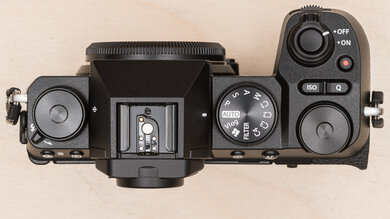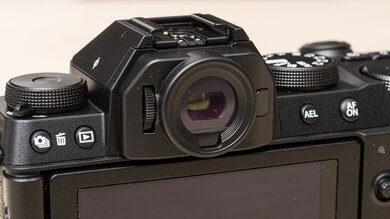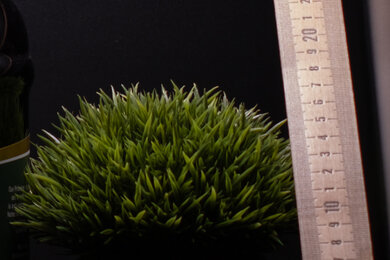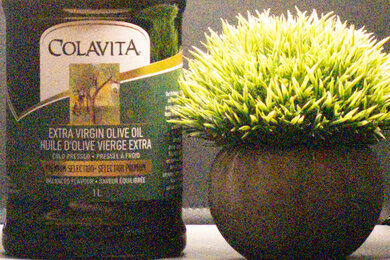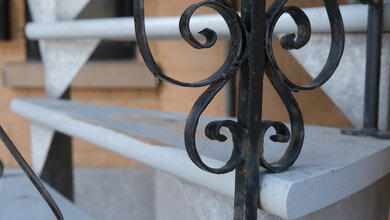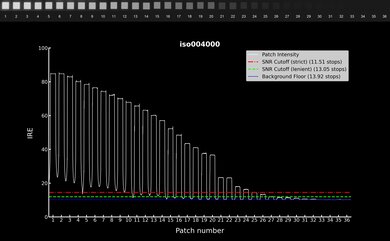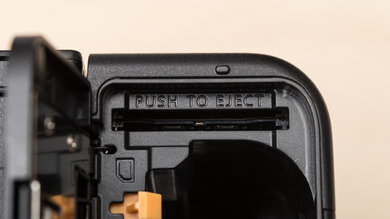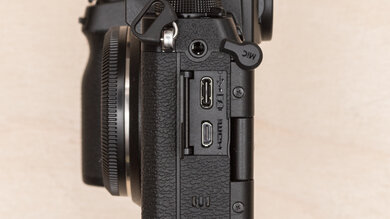The Fujifilm X-S20 is a mid-range hybrid mirrorless camera, replacing 2020's Fujifilm X-S10. This camera retains much of what makes the previous one great, including in-body image stabilization, a comfortable grip, and the same 26-megapixel X-Trans 4 sensor, but adds a new processor, a bigger battery, and better video specs. All those upgrades make this a compelling mid-range choice for photographers, videographers, and hybrid shooters alike, albeit at a notably higher price than its predecessor.
Our Verdict
The Fujifilm X-S20 is great for travel photography. It has a relatively portable and lightweight design that's good for travel, and its battery life is excellent for a mirrorless camera. Beyond that, image quality is great, with excellent colors straight out of the camera and film simulation profiles to play with the look and tone of your photos. Plus, its autofocus system works very well, with an excellent auto subject detection mode that automatically detects and tracks different kinds of subjects. The camera doesn't have any kind of weather sealing, though. Its viewfinder is also on the smaller side.
- Relatively portable.
- Excellent battery life.
- Great image quality and autofocus.
- Not weather-sealed.
- Viewfinder is a bit small and uncomfortable.
The Fujifilm X-S20 is good for landscape photography. Its sensor performs admirably for an APS-C sensor, with an impressive amount of dynamic range to capture more detail in high-contrast scenes, as well as decent noise handling in low light. The camera is also well-built, relatively portable, and comfortable to shoot with. However, it isn't weather-sealed, so you'll have to be more careful in adverse weather conditions.
- Relatively portable.
- Excellent battery life.
- Great dynamic range.
- Not weather-sealed.
The Fujifilm X-S20 is good for sports and wildlife photography. It has a fairly quick max burst rate, especially in its electronic shutter mode, though rolling shutter effect can be an issue with the e-shutter. If you prefer to shoot in RAW, the buffer also fills up quite quickly, but in JPEG, it's virtually infinite, so you can shoot continuously for as long as you want. The autofocus works well, with a great tracking feature for moving subjects and several different subject detection modes, including birds, animals, and vehicles. However, the implementation isn't the most intuitive, with the human subject detection setting separate from the other subject detection modes. The automatic subject detection feature is also only available in the auto shooting mode, which is a bit of an oversight.
- Relatively portable.
- Excellent battery life.
- Quick burst shooting.
- Accurate and responsive AF tracking.
- Not weather-sealed.
- Viewfinder is a bit small and uncomfortable.
- Subject detection could be implemented better.
The Fujifilm X-S20 is good for vlogging, though it's a bit on the bulkier side for walk-and-talk vlogs. It's a very capable video camera, with 4k recording at up to 60 fps and more advanced features like open gate 6.2k output via HDMI and Log profiles for a wider dynamic range. It has a fully articulated screen that lets you monitor yourself while recording. It also has a dedicated 'Vlog' mode that lets you adjust certain settings on the touchscreen when it's facing you, as well as enabling the vlog-centric 'Product Priority' and 'Background Defocus' modes. The camera can overheat during long recording sessions, and the rolling shutter effect is pretty bad. You may notice some distracting "wobble" in the background of your vlogs when you pan or move the camera too quickly.
- Relatively portable.
- Internal 4k 60 fps 10-bit 4:2:2 recording.
- Fully articulated screen.
- Handy 'Vlog' mode.
- Not the most portable for on-the-go vlogging.
- Rolling shutter effect is very noticeable.
- Overheats pretty quickly in 4k and 6.2k.
The Fujifilm X-S20 is good for studio video. It can record 4k / 60p 10-bit 4:2:2 video internally and even supports open gate 6.2k recording and RAW video output via HDMI, making this a seriously capable mid-range video camera. The headphone jack on the body also eliminates the need for a USB-C adapter. On the flip side, it doesn't have the best heat management, as it can quickly overheat in both the 6.2k and 4k modes, though you can buy an additional cooling fan attachment to help with this. You can extend the battery life if needed by powering the camera with an external power supply over USB-C.
- Relatively portable.
- Internal 4k 60 fps 10-bit 4:2:2 recording.
- Open gate 6.2k recording.
- Supports RAW video output to a compatible external recorder.
- Rolling shutter effect is very noticeable.
- Overheats pretty quickly in 4k and 6.2k.
The Fujifilm X-S20 isn't meant for POV-style action footage but is good for recording action from the sidelines. With 4k recording at up to 60 fps and a high-speed recording mode that records slow-motion footage at up to 240 fps in 1080p, it offers plenty of frame-rate options to capture fast action. This camera isn't designed for action cam rigs and lacks any kind of water resistance.
- Relatively portable.
- Good selection of frame rates.
- Not an action camera.
- Not waterproof.
The Fujifilm X-S20 has good RAW image quality. Its high-resolution sensor captures images with plenty of fine detail, and its dynamic range is impressive, so it's quite well-suited to high-contrast scenes. That said, its noise handling is only decent in low light.
- Great dynamic range.
- High resolution sensor.
- Noise handling is just decent.
Performance Usages
Changelog
-
Updated Feb 12, 2025:
We wrote text for the new tests added in Test Bench 0.13.
- Updated Feb 03, 2025: We've converted this review to Test Bench 0.13. We've added new tests for Video Dynamic Range and Luminosity Patch Detection. You can learn more about these updates in the changelog.
- Updated Aug 20, 2024: We added a comparison to the Fujifilm X-T50 in the Portability box.
- Updated Jan 29, 2024: Added text to the 'Raw Photo Performance' verdict box.
Check Price
Differences Between Sizes And Variants
The Fujifilm X-S20 comes in one color, black. You can see our unit's label.
You can buy the camera body on its own or bundle it with a kit lens like the XF 18-55mm f/2.8-4 R LM OIS or the XC 15-45mm f/3.5-5.6 OIS PZ.
If you encounter any other variants or your X-S20 doesn't match our review, let us know, and we'll update the review.
Popular Camera Comparisons
The Fujifilm X-S20 is a highly capable mid-range APS-C camera, with plenty to offer for photographers and amateur videographers/vloggers alike.
For more options, check out the best vlogging cameras, the best cameras for beginners, or the best mirrorless cameras.
The Fujifilm X-S20 and the Fujifilm X-T50 are both great mid-range models from Fujifilm, but they're aimed at different users. The X-T50 has a more photography-oriented design, with a compact body and more control dials, in addition to a higher-resolution sensor that's better suited to photography. The X-S20, on the other hand, has better ergonomics overall, and its articulating screen and simpler PSAM dial lend themselves better to video work.
The Fujifilm X-T5 is better overall than the Fujifilm X-S20, though they're aimed at different users. The X-T5 is a higher-end camera with better build quality, including weather-sealing. It also has a higher-resolution sensor and higher-resolution EVF, along with dedicated exposure dials, that make it a good fit for enthusiast photographers. The X-S20, on the other hand, is aimed more at general content creators and vloggers, with a fully articulated screen and more 'auto' features.
The Sony α6700 and the Fujifilm X-S20 are both excellent mid-range hybrid cameras. The Sony has a better autofocus system and more advanced features like 4k 120 fps recording. It also has a slightly more portable, rangefinder-style design. On the flip side, the Fujifilm has a higher-resolution screen and supports 6.2k recording at up to 30 fps, along with RAW video output via HDMI. Both cameras deliver excellent image quality, have in-body image stabilization, and have a wide selection of lenses. Ultimately, you can't go wrong with either, and the decision will largely come down to your personal preferences and needs.
The Fujifilm X-S20 offers some notable improvements over the Fujifilm X-S10 but also sits at a higher price point. Both cameras use the same sensor and deliver comparable image quality, and both have in-body image stabilization and comfortable ergonomics. However, the X-S20 has a new processor, improved autofocus, a bigger battery, and enhanced video capabilities.
Test Results

The Fujifilm X-S20 is similar in size to its predecessor but is a touch heavier and wider. Overall, it's still a fairly portable camera, and its relatively large handgrip may be worth the trade-off in portability for those who prefer more comfortable ergonomics. If, however, you're looking for something more compact, the Fujifilm X-T50 may suit you better.
The camera's build quality is great. It doesn't feel as premium as higher-end models like the Fujifilm X-T5 or the Fujifilm X-H2 / Fujifilm X-H2S, but it still feels sturdy overall. The top and bottom plates are made of magnesium alloy, while the rest of the body is made of hard plastic. Some buttons have been slightly redesigned from the Fujifilm X-S10, with a slightly clickier feel that provides good physical feedback. The grip also has a slightly grippier texture than the grip on the X-S10. The screen mechanism and flash mechanism feel solid, too. Unfortunately, there's no weather sealing on the camera. It's also worth noting that the shoulder strap attachment points aren't fixed like on a camera like the Sony ZV-E1. They're still sturdy, but they could rattle around and cause some noise if you plan on shooting video.
Even though the Fujifilm X-S20 doesn't have the vintage-style exposure dials that Fujifilm X-T series cameras are known for, its three customizable command dials still make it quite easy to adjust settings.
The X-S20 is also compatible with the FAN-001 cooling fan that Fujifilm sells for the Fujifilm X-H2S / Fujifilm X-H2. It screws into the mounts behind the screen. It's worth noting that while the camera's cooling fan connector cover can attach to the cooling fan for safekeeping, the fan connector cap on the cooling fan itself can easily be misplaced (see step 2 here for more info).
The camera is very comfortable to shoot with. The hand grip is a touch wider than the grip on the original Fujifilm X-S10, which was already very comfortable, to accommodate the larger battery. The thumb rest on the back is also more pronounced, so it feels great in hand, with plenty of room for hands of various sizes. On the other hand (no pun intended), some buttons might be harder to reach or awkwardly placed if you have small hands. That's especially true if you're vlogging and have the camera facing you since some back buttons are also flat and harder to press from that position. The viewfinder also isn't the most comfortable, with a hard plastic eyecup that doesn't protrude very far from the body.
Nothing new with the viewfinder, as it's pretty much identical to the one on the Fujifilm X-S10. It has a typical 2.36 million dot resolution, which isn't surprising at this price point. It isn't the highest-resolution EVF out there, but it's perfectly fine for the price. It's a little on the smaller side but isn't bad overall.
The screen is fully articulated, with a higher resolution than the display on the Fujifilm X-S10. You can use the touchscreen to select an autofocus point or focus area, as a touch shutter, or to adjust certain settings in video mode. The new dedicated 'Vlog' mode also lets you access and adjust settings relevant to vlogging, as seen here. That comes in handy when the screen flips around to face you. On top of that, the screen supports swipe gestures, which you can customize to access different settings whenever you swipe up, down, left, or right from the edge of the screen. However, you can't scroll through the menus with touch gestures.
The menu system is great overall, especially once you get used to it. For example, some of Fujifilm's terminology differs from other brands, like metering settings being labeled 'Photometry'. It's relatively easy to navigate, and there are plenty of customization options, including 'My Menu' pages to access your most frequently used settings, in addition to the quick menu that you can pull up while shooting.
You can also download Fujifilm's XApp (screenshot of the app interface here), which lets you control the camera remotely, back up your settings, get notified about firmware updates, and transfer files from your camera directly to your smartphone (excluding RAW files). Using the app for Live View works okay, but it can be very laggy.
The Fujifilm X-S20 has the same fourth-generation 26 MP X-Trans sensor as its predecessor—the same one found on many Fujifilm cameras since 2018, including the Fujifilm X-T4. However, it uses the new X-Processor 5, which Fujifilm claims is twice as fast as the previous generation.
The Fujifilm X-S20 has an excellent battery life thanks to its new, larger NP-W235 battery, which is the same battery found on higher-end models like the Fujifilm X-T5 and Fujifilm X-H2S. The X-S20 is CIPA-rated for 750 shots in normal mode and 800 in its power-saving economy mode. That's a big improvement over the 325-shot CIPA rating of the Fujifilm X-S10. While your real-world battery performance will vary depending on how you use your camera, it's a fantastic rating for a mirrorless model.
The camera is also great regarding video. We tested a little over 110 minutes of continuous 4k video recording on a full charge, which is great for longer recording sessions. You can also power the camera externally with a USB power bank or adapter.
Using the mechanical shutter, The camera can shoot at a fairly quick max burst rate. Switching into electronic shutter mode gets you much quicker 20 fps burst shooting, though, of course, the electronic shutter can cause distorted vertical lines, so it's less suitable for tracking fast-moving subjects. You also have the option to shoot at 10, 20, or 30 fps in the electronic shutter mode with a 1.25x crop.
Unfortunately, it doesn't have the largest buffer when shooting uncompressed RAW files, though it's still an improvement over the Fujifilm X-S10. That said, if you shoot JPEG or compressed RAW files, it can capture over 1,000 frames when using the mechanical shutter, which is capped at 8 fps. If you switch over to electronic shutter mode, on the other hand, the buffer fills up after about 185 JPEGs at 20 fps (with a 21s empty time) or about 412 JPEGs when using the cropped 30 fps speed (with a 35s empty time).
The Fujifilm X-S10 has the improved AF algorithm of newer Fujifilm models like the Fujifilm X-T5 and Fujifilm X-H2S. So, unlike the Fujifilm X-S10, it now has expanded subject detection modes for animals, birds, trains, automobiles, and motorcycles, in addition to human face and eye detection. However, just like those models, the subject detection modes are organized as separate from the human face/eye detection setting, which can be a bit of a hassle if you want to quickly go from shooting planes to people, for example. There's an auto subject detection feature that automatically detects what subject you're shooting, whether it's a person or a plane, and tracks them accordingly. Unfortunately, it's only available when the camera's in 'Auto' shooting mode. Still, the AF tracking is a big improvement over its predecessor's. Overall, it does a great job of keeping moving human subjects in focus, and you're likely to get a solid hit rate, even with faster or more erratic subjects.
Unfortunately, the camera's autofocus is inconsistent when you turn off tracking. Sticking to a center focus point, it'll sometimes miss focus and jump to the background or foreground, even when you keep the focus point on the intended subject. We tested the AF with both the XF 18-55mm F2.8-4 R OIS and XF 16-55mm f/2.8 R LM WR lenses, and the AF performed similarly with each. That said, the autofocus performs much better if you use center point focusing but keep face detection enabled. Ultimately, as far as AF-C goes, letting the camera detect and choose a subject for you leads to more reliable results than simply choosing your own focus point.
The camera has a five-axis in-body image stabilization system, which Fujifilm rates for up to 7 stops of stabilization. That's an improvement over the advertised 6 stops on the Fujifilm X-S10. We managed to get clear images at very slow shutter speeds when shooting handheld, so it's very effective overall. We tested stabilization with the optically stabilized XF 18-55mm F2.8-4 R OIS lens. It's worth noting that stabilization can vary depending on many factors, including the lens you use, the focal length you shoot at, and how steady your hands are.
The sensor has great dynamic range, capturing a wide array of highlight and shadow detail. It's roughly on par with APS-C competition like the Sony α6600 and slightly outperforms the higher-resolution Canon EOS R7.
The camera captures a good amount of fine detail, but it isn't remarkable. You have some leeway to crop in your photos without losing too much resolution, but images aren't as sharp or detailed as they are on higher-resolution models like the Fujifilm X-T5.
The camera has decent RAW noise handling. It's better suited to low-light shooting at high ISO settings than a competitor like the Sony α6600, for example.
The Fujifilm X-S20 supports video recording in 6.2k resolution at up to 30 fps and 4k or FHD at up to 60 fps. You also have the option to shoot DCI 4k in a slightly wider, more cinematic 17:9 aspect ratio. With a compatible Atomos or Blackmagic recorder, the camera can output 12-bit RAW video over HDMI in ProRes RAW or Blackmagic RAW, respectively. On top of that, the X-S20 also supports the new F-Log 2 format, in addition to standard F-Log, to capture an even wider dynamic range and give you more flexibility when color grading. Ultimately, it's a big step up from the Fujifilm X-S10 when it comes to video features, inheriting some high-end video specs from its flagship siblings, the Fujifilm X-H2 and Fujifilm X-H2S.
Another new feature on the X-S20 is the dedicated 'Vlog' mode, which replaces the 'SP' or Scene Position setting on the mode dial, which tracks with the broader market trend of appealing to content creators and vloggers. The different creative scenes from the old 'SP' mode are now incorporated into the 'Auto' mode.
The Vlog mode differs from the regular Movie mode in several ways. For one, it adds a 'vlog' settings quick menu to the touchscreen, so you can easily adjust settings while the screen is facing forward. It also gives you access to two additional features: 'Background Defocus Mode' and 'Priority Products Mode'. If those sound familiar, it's because they follow in the footsteps of the 'Background Defocus' and 'Product Showcase' features that Sony has been implementing in its ZV vlogging cameras since the Sony ZV-1. In any case, the Background Defocus Mode sets the aperture to the widest available on your chosen lens. The amount of background blur you get will depend on several factors, not just the max aperture but also your distance to the lens and focal length. The Priority Products Mode disables face/eye detection to allow the camera to pick up any objects you hold up in front of the lens, which can be helpful for product vloggers.
Unlike older models, the X-S20 now supports the UVC/UAC standard, so you can stream and use it as a webcam by simply plugging it into a PC without additional software.
The camera can record 4k video at up to 60 fps, though recording at the max 60 fps incurs a slight crop. Still, cropped 4k 60 fps is better than the Fujifilm X-S10, which was limited to 4k at up to 30 fps.
The camera has impressive internal recording specs, especially for a mid-range camera. It can capture 10-bit 4:2:2 4k video internally—a notable improvement over the 8-bit 4:2:0 recording of the Fujifilm X-S10. 10-bit means you'll have much more flexibility with your footage when recording in Log. Accordingly, the X-S20 now adds F-Log 2 on top of the standard F-Log to capture an even wider dynamic and tonal range. On the flip side, the X-S20 is prone to overheating. The 'Auto Power Off Temp' setting, similar to the 'Auto Power OFF Temp' setting on Sony cameras, lets you raise the camera's temperature threshold before it shuts down. However, Fujifilm only recommends using the 'High' setting when not shooting handheld. When set to 'Standard', the camera shut down after about 26 minutes of continuous video recording in 4k at 30 fps. You can also buy the optional FAN-001 cooling fan, which attaches to the body while the screen is extended and can help prevent overheating.
The autofocus performs inconsistently in 4k. Even after playing around with the sensitivity and speed settings and trying a different lens, we experienced a fair amount of chasing and pulsing when tracking a moving human subject, particularly whenever the subject leaves the frame and returns. Overall, it's underwhelming, especially considering the other Fujifilm cameras with this new AI-powered autofocus, like the Fujifilm X-T5 or the Fujifilm X-H2S, perform much more reliably. The X-S20 has the same quirks in implementation as those cameras, with human face/eye detection separate from the other subject detection modes. However, it does have an auto subject detection feature that bypasses that by automatically detecting if a human or other subject is in the frame. Unfortunately, it's only available in the camera's Auto shooting mode.
The camera's 4k video quality is excellent. It's quite crisp and detailed, though shooting at 60 fps in 4k incurs a bit of a crop, as you can see here. For even more detailed footage, you can record in open gate 6.2k with a 3:2 aspect ratio. You can see a test scene extract of that here. 4k video looks pretty good in low light, but some noise and loss of detail is inevitable.
Unfortunately, the rolling shutter effect is pretty bad on the Fujifilm X-S20. If you pan the camera or move it around quickly, you'll see some noticeable skewing with vertical lines.
The Fujifilm X-S20 can record regular full-speed 1080p video at up to 60 fps without a crop. Like other cameras from this brand, it has a high-speed recording mode that can record slow-motion footage at up to 240 fps, with playback options for 2x, 4x, or 8x slow motion. This mode doesn't record any sound and imposes a notable crop.
As with 4k, the Fujifilm X-S20 has impressive 1080p internal recording specs. There's no recording time limit, which is great for longer recording sessions or streaming. It also supports 10-bit 4:2:2 capture internally, giving you more leeway in post. That said, bit rates fall short of the advertised 360 Mbps.
We experienced much better AF performance in 1080p than in 4k, with more reliable human subject tracking and less hunting. However, outside of the subject detection modes, it's less consistent. For example, if you want to maintain focus on an object that's coming towards you or away from you, it can be sluggish to keep up.
Video quality in 1080p is great in more controlled lighting, but noise is more present in low light, with muddier details. The video quality also degrades significantly in the high-speed recording mode, especially at 240 fps, as you can see here.
Thankfully, rolling shutter is better in 1080p. You'll still get some skewing, but it's notably better than in 4k and most noticeable when panning the camera very quickly.
The Fujifilm X-S20 has remarkably wide video dynamic range. It has a very wide total dynamic range above the background floor, and much of that dynamic range is usable, depending on your tolerance for noise.
Tested Settings:
- Resolution: 4k
- Frame Rate: 30 fps
- Log Format: F-Log2
The camera has great latitude both above and below middle gray. The number of stops detectable in the shadows and highlights stays quite consistent as you raise your ISO as well.
Tested Settings:
- Resolution: 4k
- Frame Rate: 30 fps
- Log Format: F-Log2
You're still only getting a single SD card slot, but unlike the Fujifilm X-S10, it's rated for faster UHS-II cards. It's on the bottom of the camera, next to the battery slot. A locking, hinged door covers the compartment.
The Fujifilm X-S20 has a full suite of inputs and outputs, including both a microphone input and, unlike the original Fujifilm X-S10, also includes a headphone jack, which is on other side of the camera. It uses a modern USB-C port for charging, power supply, streaming, and file transfer. There's also a Micro HDMI port to connect an external display or recorder, though you'll likely need an adapter for full-sized HDMI cables.



